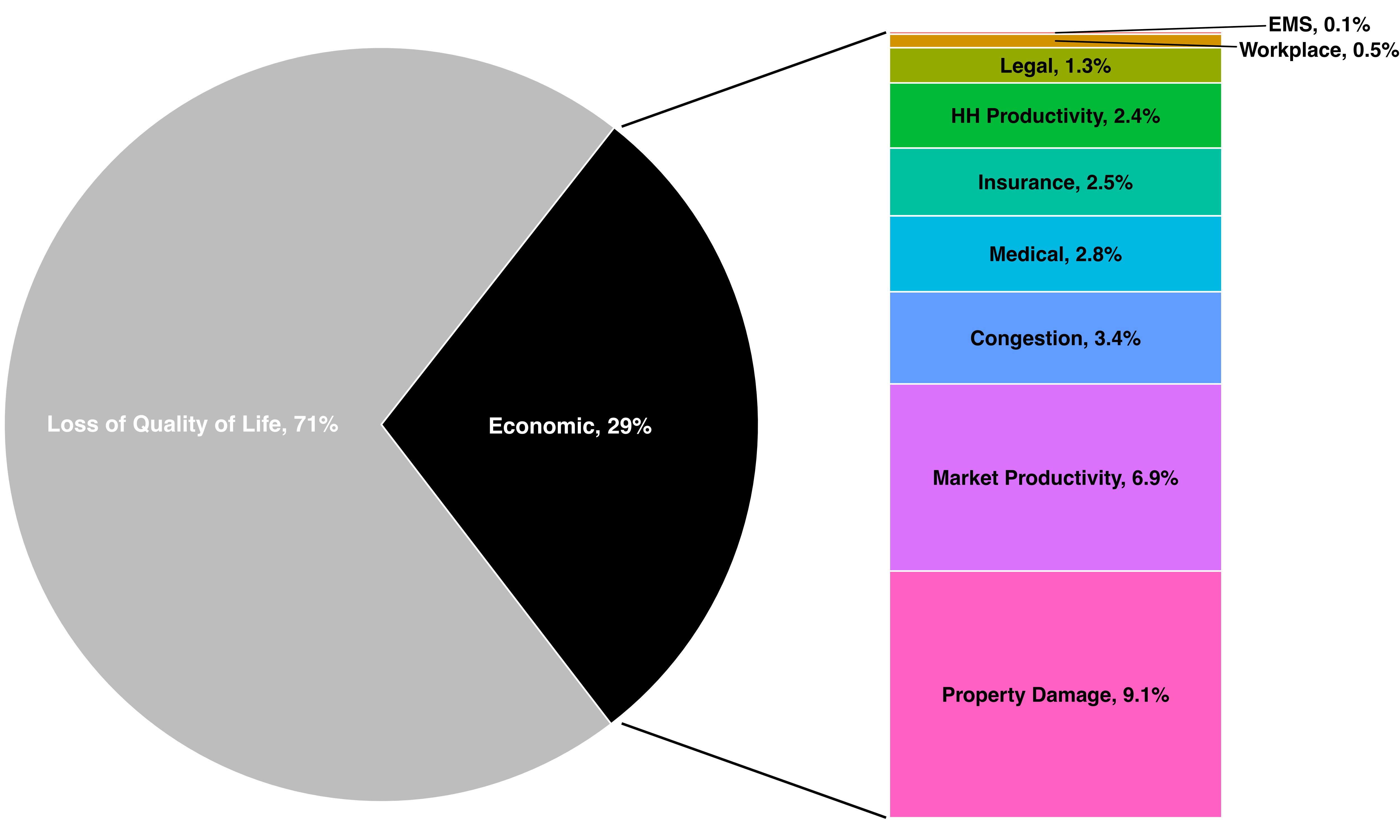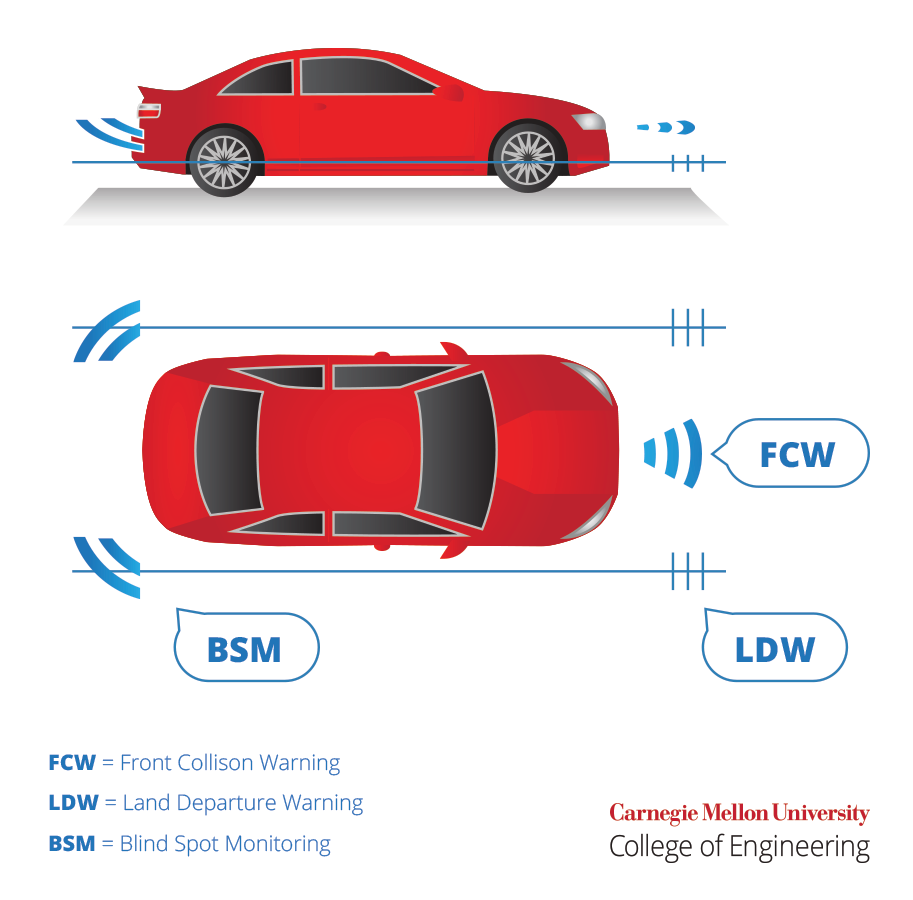Finding big savings in driver-assisted safety tech
Driver-assisted safety systems reduce the likelihood of crashes. How much would society benefit if they were installed on all cars? More than $20 billion, according to research from CMU.
Driving is dangerous.
Millions of vehicle crashes occur each year in the United States. In 2015, there were roughly 6.3 million crashes, resulting in close to 36,000 deaths. Since the year 2000, more Americans have died in car crashes than in both World Wars combined.
“Transportation is critical to our everyday lives, and yet for most of us, riding in a car is one of the riskiest activities we do,” says Costa Samaras, associate professor of civil and environmental engineering (CEE).
That risk carries significant costs. Some are immediate and obvious, such as losses of limb and life, or damage to one’s car. Other costs are more dispersed, such as increased congestion, overfull emergency rooms, and lost productivity in the workforce. Each of these costs can be thought of as either falling on the shoulders of the individuals in the crash (“private costs”) or affecting the public at large (“public costs”). The average crash represents more than $160,000 in combined private and public costs, according to recent research by Samaras and colleagues.

Source: Figure: College of Engineering. Data: NHTSA
Quantifying the damages of car crashes: how societal costs break down across categories.
Alerting drivers to potential threats through “driver-assist” warning systems has been shown to reduce the odds of a crash. Using cameras or radar, each tool detects potentially dangerous anomalies, such as drifting from a lane, and alerts drivers to the threat. The study, led by CEE Ph.D. graduate Corey Harper and published in the journal Accident Analysis and Prevention, lays out the costs and benefits of three driver-assist technologies: blind-spot monitoring (BSM), lane-departure warning (LDW), and forward collision warning (FCW). The researchers find that, if these warning systems were installed on all cars in the US, the resulting reduction in crashes would put a lot of money back in our collective pockets.

Source: College of Engineering
Driver-assisted warning systems alert drivers to potential threats.
Human error is responsible for 94% of all crashes, according to the National Highway Traffic Safety Administration (NHTSA). Removing humans from behind the wheel is the promise of fully autonomous vehicles. However, that future may be decades away, according to many experts.
As we wait for robot drivers, technologies like these are already having a meaningful impact on road safety. The combined effectiveness of the three technologies in preventing crashes is 3.5%, according to data from NHTSA. That eliminates between three and four of every hundred crashes that occur without these systems, avoiding more than 220,000 crashes each year when applied to the entire U.S. fleet. And if the effectiveness of these technologies were to improve, that number would only increase as, collectively, BSM, LDW, and FCW are relevant to one quarter of all crashes.
When the team compared the potential savings from avoided crashes with the fees that would be associated with installing the safety features on all cars, they found the net benefit to society to be $20.6 billion each year. This is roughly equal to the annual budget of NASA. Were the effectiveness of the technologies to improve further, the benefits could be as high as $250 billion, if each relevant crash were prevented.

Source: College of Engineering
Corey Harper, now a Presidential Post-Doctoral Fellow in CEE.
The potential savings were even higher when the team added automatic emergency braking (AEB) to the mix of considered safety technologies. AEB is a step closer to autonomous driving: it proactively slows a car when a driver fails to heed a front-collision warning. Adding automatic emergency braking on top of the three warning technologies reduces crash frequencies by 7.5%, pushing up the societal benefits to $59.2 billion.
However, none of these safety systems are currently widely adopted, nor are they standard on all new vehicles, despite their low price tag. To install the three driver warning systems costs a consumer about $600 per car. “The systems we assessed are cheap and getting cheaper,” said Samaras, noting that the technology costs have steadily decreased in recent years.
“We found a big societal benefit,” said Harper. “But we also wanted to know ‘is there a benefit to the individual purchasing these technologies?’” How the benefits are distributed would likely influence drivers considering their return on investing in these safety features. Overwhelmingly, the team found that the benefits fall to individuals, not the public at large. Reducing the number of crashes provides distributed benefits—less congestion, fewer taxpayer-supported emergency responses—but most of the big savings are private (86%), largely coming in the form of avoided injuries, fatalities, and damage to vehicles.
We don’t have to wait for a future with fully self-driving cars to realize a lot of the benefits of sensing and automation. A lot of crashes can be avoided with today's tech.
Corey Harper, Presidential Post-Doctoral Fellow, Civil and Environmental Engineering
“We don’t have to wait for a future with fully self-driving cars to realize a lot of the benefits of sensing and automation,” says Harper. “A lot of crashes can be avoided with today's tech.” It just needs to be installed.
Other collaborators on this study include Chris Hendrickson, professor of civil and environmental engineering and Abdullah Khan, Heinz School graduate.
